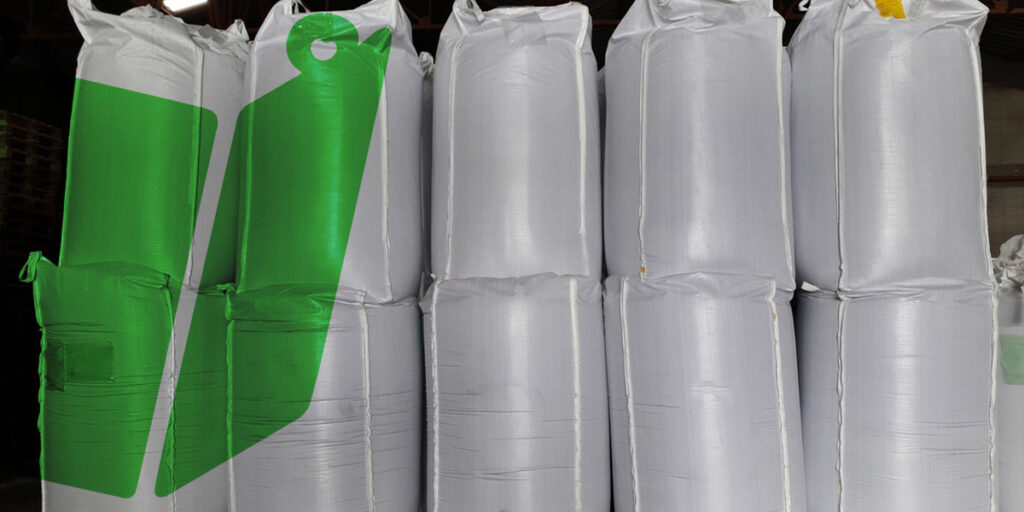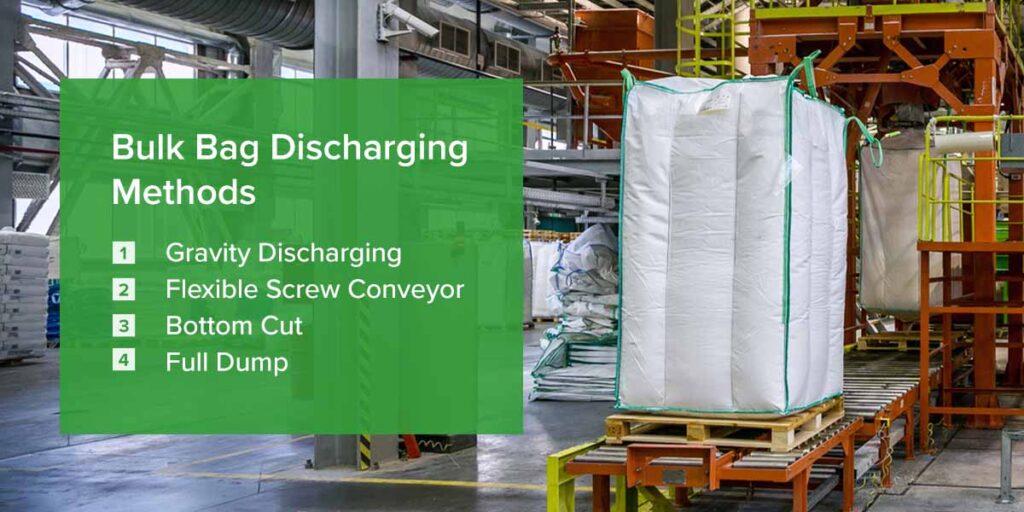How to Optimize Your Bulk Bag Discharging Process
Bulk bags are necessary for storing and transporting dry loose goods in many industries, from agriculture to construction to pharmaceuticals. These bags, also known as flexible intermediate bulk containers (FIBCs), enable companies to contain and handle a range of raw materials safely.
Bulk bag dischargers are systems designed to empty these bags of their contents safely and effectively to avoid product loss and minimize dust. Discharging processes often struggle to achieve smooth material flow. Your facility’s needs and the materials you handle may introduce specific challenges for your bulk bag discharge system.
Learn tips for optimizing the bulk bag unloading process in this guide.
Bulk Bag Discharging Safety
Before you consider bag discharging methods and bag types to help update your process, you must consider the system’s safety requirements. Discharging a bulk bag can become dangerous if operators don’t use the correct safety measures and equipment. Consider these strategies for improving bulk bag discharging safety:
Following Operator Safety Tips
Operators should follow these general bulk bag lifting guidelines to handle each bag safely:
- Ensure the bag is undamaged: Check all bags for signs of damage before hoisting them.
- Keep out from under a suspended bag: Workers should always steer clear of bulk bags during suspension to avoid accidental injury.
- Lift a bag before moving it: Moving a bag without properly lifting it could result in poor ergonomics and injury.
- Ensure bags and equipment are in place: During handling, ensure all bags and equipment are in the proper place to maintain good ergonomics. For instance, operators should be able to untie a bag outlet without straining to reach it.
Using Appropriate Bulk Bag Discharging Equipment
Filling bulk bags is easy with the right bulk bag loading equipment. Yet when you need to discharge their contents, you might need more specialized equipment. Using the right bulk bag discharging equipment is critical for maintaining safety throughout the discharging process.
Here are a few tips for safely using bulk bag unloaders:
- Use the appropriate equipment: The bulk bag dischargers your facility uses depend on the materials you handle. Your facility may sometimes need custom bulk bag dischargers to achieve peak performance.
- Practice safety when using machinery: Workers should be cautious when operating discharge equipment. For example, operators should never reach between the discharging equipment’s moving parts.
- Replace machinery when needed: Repair or replace bulk bag discharging equipment when required to maintain safety in the facility.
Bulk Bag Discharging Methods
Facilities can use several methods for discharging bulk bags. Material flow is a significant consideration when determining what bulk bag discharging method to use. Some materials are more abrasive or have a higher density than others, which impacts their flow. Using the wrong bulk bag discharge system for a material can result in poor material flow or high product loss.
If you’re unsure about the best types of bulk bag discharge equipment and bags you need for a product, conduct a flow test on your material. A flow test calculates a material’s density, particle size and shape, angle of slide and angle of repose.
Once you’ve conducted a flow test, consider the following discharging methods and which might be best for your material:
1. Gravity Discharging
With gravity discharging, the discharging equipment lifts the bag over the discharge area and opens the spout for the material to flow freely. Many facilities use bulk bag unloaders that keep the bulk bag in place and control the product flow for more accurate gravity discharging.
2. Flexible Screw Conveyor
A flexible screw conveyor uses a rotating spiral to process materials continually during discharge, which is helpful for blended products. Flexible screw conveyors are versatile machines that work well with free-flowing and non-free-flowing materials. Facilities can place multiple discharge points along the conveyor to feed a line of processing machines.
3. Bottom Cut
Many bulk bags feature a spout for easy discharge of their contents. For those that don’t, the bottom cut discharge method is a practical approach.
By making a C-shaped cut on the bottom of the bag, you can discharge the material without a spout. However, you have less control over the speed and direction of the product flow. Installing a discharge system with a flow control valve could solve the challenge.
4. Full Dump
With a full dump, a facility opens the entire bottom of the bulk bag to dump the contents all at once. This method is efficient and fast.
However, the full dump process provides even less control over the material’s flow. Use bulk bag dischargers that enable greater control over the flow if you employ this method.
Types of Bulk Bags and How to Empty Them
As your facility optimizes its bulk bag discharging processes, consider the various types of bulk bags available from FIBC bulk bag manufacturers. Using the right bag for your product can streamline the discharging process.
1. Duffle Top
A duffle top bulk bag has a duffle opening at the top of the side panels. This larger opening allows greater flexibility when discharging your bulk bag.
Duffle bags without baffles are ideal for bulkier materials. Because duffle top bulk bags essentially have a lid, the best discharging method to use with them is gravity discharging.
2. Spout Top
A spout top bulk bag has a cylindrical spout sewn into the top panel of the bag. These bags work well with many kinds of materials, especially those with small particles, as the spout minimizes dust.
The spout efficiently directs the product flow, whether you’re filling or discharging the bag. Spout top bags work well with the gravity discharging method and the flexible screw conveyor method.
3. Open Top
If your facility handles materials that can’t spill or generate dust or need proper ventilation, open top bulk bags may be your best solution. An open top bag is simply a bag with a hole in the top, which provides little control over the material flow and poor protection from spillage. You can use the bottom cut or full dump discharge method with these bags.
4. Baffled
A baffled bulk bag is ideal in applications where stacking the bags is required. Unlike standard bulk bags, these bags maintain their shape, which prevents leaning. Baffled bags often have a spout top, making them ideal for the gravity or flexible screw conveyor discharging methods.
Whatever type of bulk bag or discharging process you use, agitation can optimize the process. Agitation breaks up packed materials and speeds up discharge to make the process more effective.
Buy Bulk Bags From Bulk Bag Reclamation
Bulk Bag Reclamation can help you streamline your bag discharging process while cutting costs and increasing profit. Our refurbished bulk bags are a low-cost packaging solution for various applications. We carefully inspect our bags for defects and clean them to minimal residue standards to ensure every bag meets our quality standards.
To learn more about our bulk bags, contact us today. You can also browse our inventory of reconditioned bulk bags to find the right solution for your facility.



